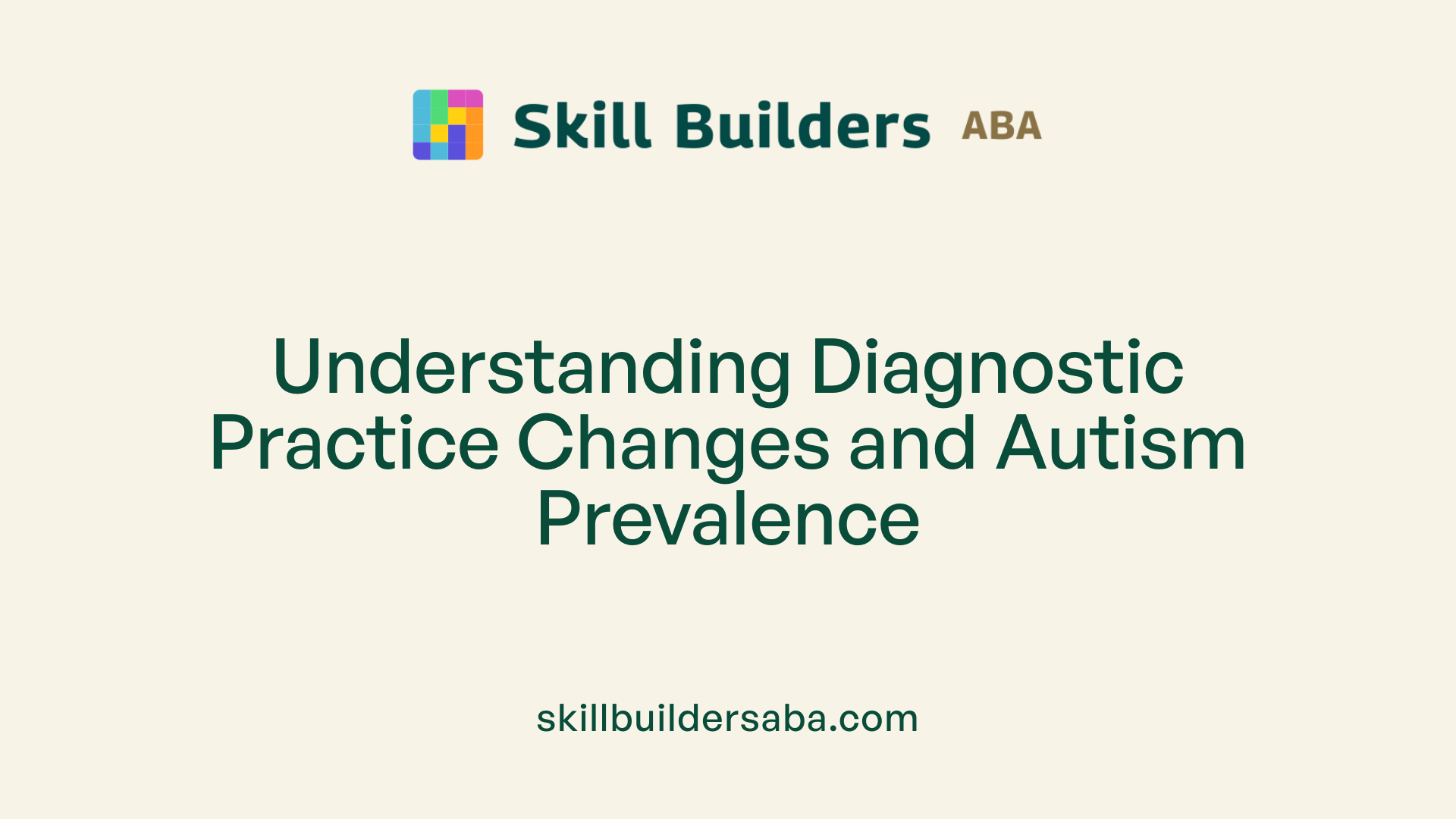Why Is Autism Increasing?
Unraveling the Rising Tide of Autism Diagnoses

Understanding the Surge in Autism Spectrum Disorder
Over the past two decades, autism spectrum disorder (ASD) diagnoses have increased significantly across populations worldwide, prompting urgent questions about causes, implications, and future directions. This article explores the multifaceted factors contributing to this rise, examining genetic, environmental, diagnostic, and societal influences, supported by recent research and epidemiological data.
Growth in Autism Prevalence: Data and Trends

What are the current statistics on autism prevalence globally and in the United States?
Recent data from the CDC's Autism and Developmental Disabilities Monitoring (ADDM) Network estimate that about 1 in 31 children in the U.S. are diagnosed with autism spectrum disorder (ASD) as of 2022. This marks a significant increase from earlier decades, where prevalence was around 1 in 150 in 2000. Globally, the World Health Organization reports that autism affects approximately 1% of the population, a rise from 0.62% in 2012.
In the United States, the prevalence among children aged 4 to 8 has shown a consistent upward trend. For example, among 4-year-olds born in 2018, the prevalence was approximately 2.93% or 1 in 34 children. By age 8, this prevalence increases slightly, with recent estimates indicating about 1 in 31 children are affected.
How does autism prevalence vary by age, gender, ethnicity, and region?
Autism diagnoses are most common among children aged 5 to 8 years, with the highest prevalence rates observed in this group. The data also reveal that boys are significantly more affected than girls, with a ratio of around 3.4 boys for every girl. Interestingly, the percentage of girls diagnosed has increased, with recent reports showing that the prevalence among girls has surpassed 1% for the first time.
Racial and ethnic disparities are evident. Minority children—Hispanic, Black, Asian, and American Indian/Alaska Native—have reported higher prevalence rates than white children in many regions. For instance, in Maryland, Black children face a prevalence rate of about 1 in 27 among 8-year-olds.
Geographically, prevalence varies widely across the U.S., with rates ranging from approximately 9.7 per 1,000 children in Texas to 53.1 per 1,000 in California. Such differences mostly reflect variation in screening practices, awareness, and resource availability.
What role do screening and diagnostic improvements play in the rising autism rates?
Over recent years, advances in screening tools, such as the Modified Checklist for Autism in Toddlers (M-CHAT), and broader, more inclusive diagnostic criteria have significantly impacted autism prevalence data. These developments have led to earlier detection and diagnosis, often picking up mild or less obvious cases that previously went unnoticed.
Changes in diagnostic criteria, especially with the introduction of DSM-5 in 2013, have expanded the definition of autism spectrum disorder. This broadening includes subcategories like Asperger’s syndrome under ASD, increasing the total count of diagnosed individuals.
Empirical analyses indicate that about two-thirds of the rising prevalence can be attributed to these changes. For example, diagnostic substitution—children previously diagnosed with intellectual disabilities now classified as autistic—also contributed to the increase.
State-level variations in screening policies and implementation further explain some differences in prevalence rates. Overall, improved diagnostic sensitivity, increased community awareness, and reduced stigma are primary drivers behind the observed growth in autism cases.
How do diagnostic practice changes influence autism prevalence data?
Changes in diagnostic practices, including revisions of criteria in DSM editions and state-specific screening protocols, have played a significant role in increasing recorded autism prevalence. Empirical studies, such as those analyzing California data, estimate that roughly 26% of the rise in autism cases can be attributed to diagnostic substitution, accretion, and broader criteria.
Updates to diagnostic standards, like DSM-IV, DSM-IV-TR, and DSM-5, have expanded the autism spectrum and altered classification, thereby influencing who receives a diagnosis. Increased awareness and screening efforts have also led to earlier and more frequent diagnoses, contributing to higher prevalence figures. Overall, while improved awareness and diagnostic tools have identified more cases, a substantial part of the increase reflects changes in diagnostic practices themselves.
| Aspect | Impact | Additional Details |
|---|---|---|
| Diagnostic criteria | Broadened definitions | New DSM editions included more subcategories |
| Screening tools | Earlier detection | Use of M-CHAT and similar tools |
| Awareness campaigns | More referrals | Public campaigns increased health provider vigilance |
| Diagnostic substitution | Reclassification of cases | More cases identified as autism instead of intellectual disability |
| Regional variability | Differences in prevalence | Varies due to screening practices and resource access |
In conclusion, much of the rise in reported autism prevalence can be attributed to enhanced detection, broader diagnostic criteria, and increased awareness, although ongoing research continues to evaluate the potential role of environmental and genetic factors.
Genetic Contributions and Heritability of Autism
What is the role of genetic factors in autism?
Genetic factors are considered the primary contributors to autism spectrum disorder (ASD). Research indicates that heritability estimates range widely between 60% and over 90%, depending on the specific study and its methodology. Twin studies have been particularly instrumental in highlighting this strong genetic link, revealing that monozygotic twins—who share 100% of their genes—exhibit concordance rates often exceeding 36%. This high level of similarity underscores the significant genetic influence.
Over the years, advancements in genetic research have identified a multitude of genes associated with autism. These include both inherited mutations passed down through families and rare de novo mutations—genetic changes that occur spontaneously in the fertilized egg or early embryo. In addition, many common polygenic risk factors—small effects from numerous genes—collectively contribute to autism susceptibility.
Approximately 80% of autism cases can be traced to inherited genetic mutations, emphasizing the role of family history and genetic predisposition. At the same time, environmental factors, although less prominent, can interact with genetic factors, potentially influencing the development and severity of autism during early brain development.
This complex genetic architecture involves over 100 different genes, with some exerting a larger impact than others. Still, no single gene accounts for all cases, which illustrates the heterogeneity of autism's genetic basis.
In conclusion, the evidence from extensive genetic and familial studies supports that autism is largely driven by genetic influences. Ongoing research continues to uncover more about the ways specific gene mutations and variations contribute to the disorder, providing essential insights for diagnosis, potential interventions, and understanding individual differences within the spectrum.
For those interested in exploring this topic further, searches using terms like "Genetic research and heritability of autism" can yield detailed scientific literature and recent discoveries in this fast-evolving field.
Environmental Factors and Their Impact
Are environmental factors linked to autism?
Research indicates that environmental factors do play a role in increasing the risk of autism spectrum disorder (ASD). These influences are particularly significant during prenatal development, where exposures can affect early brain development. Key prenatal and environmental contributors include advanced parental age, maternal health conditions such as diabetes, obesity, immune disorders, and exposure to environmental toxins.
For example, maternal exposure to air pollution, pesticides, and heavy metals during pregnancy has been associated with a higher likelihood of ASD in children. Maternal infections accompanied by fever during the second trimester are also linked to increased risk, highlighting the importance of maternal health during pregnancy.
Birth complications and trauma, alongside maternal behaviors like fever and infection during pregnancy, may contribute additional risk factors. Studies have suggested that gene-environment interactions are crucial, meaning that genetic predispositions can be exacerbated by environmental exposures. Overall, while genetics are a major factor in autism development, environmental influences can modify this risk, especially in those with inherited vulnerabilities.
It is important to note that these environmental factors do not directly cause autism but may increase susceptibility when combined with genetic predispositions. Ongoing research continues to explore how these complex interactions influence autism spectrum disorder.
For further information, searching for "Environmental risk factors for autism and prenatal exposure" can provide more detailed insights into the current scientific understanding of these influences.
Myth Busting: Vaccines and Other Contributing Factors
Does increased awareness and social media influence autism diagnosis rates?
The rise in autism diagnoses over recent years can largely be attributed to heightened awareness and the pervasive influence of social media. Platforms like YouTube and Facebook allow both organizations and individuals to share educational content, personal experiences, and success stories related to autism spectrum disorder (ASD). This broad access to information fosters greater understanding and empathy, encouraging families to seek assessments earlier and more frequently.
Social media helps normalize autism by showcasing a diverse range of experiences, attributes, and successes of individuals on the spectrum. Such portrayals reduce stigma and promote acceptance, which can lead to earlier recognition and diagnosis. Nonetheless, misconceptions and stereotypes still circulate, emphasizing the importance of providing accurate and inclusive information. Increasing representation of adults and women with autism remains a challenge, but ongoing online conversations are a positive step toward broader understanding.
Can autism be cured?
It is crucial to understand that autism spectrum disorder is a lifelong condition with no current cure. While this may seem discouraging, early diagnosis combined with personalized support can significantly improve an individual’s skills and quality of life. Therapies focusing on behavioral, social, and communication skills help individuals navigate daily challenges more effectively.
Medications do not cure autism but can assist in managing associated symptoms such as anxiety, hyperactivity, or seizures. Support services and therapies are aimed at fostering independence and inclusion, enabling individuals to reach their full potential. It is essential for families to work with healthcare professionals to develop tailored intervention plans. Ongoing research continues to explore new ways to support those on the spectrum, but currently, the focus remains on management and acceptance rather than cure.
| Aspect | Details | Additional Notes |
|---|---|---|
| Impact of Awareness | Leads to higher diagnosis rates due to early and increased recognition | Social media expands access to information and reduces stigma |
| Misconceptions | Some stereotypes persist despite increased awareness | Need for more inclusive representation of all demographics |
| Cure Possibility | No known cure exists currently | Focus on support, management, and quality of life |
| Effective Interventions | Behavioral and educational therapies improve functioning | Medications manage symptoms but do not treat autism directly |
| Role of Social Media | Promotes understanding and acceptance, reduces stigma | Important for shaping public perceptions |
Overall, while myths linking vaccines to autism have been thoroughly debunked, ongoing public education is essential. The combination of increased awareness, research, and inclusive conversations continues to shape a more accurate understanding of autism and its diverse experiences.
The Complex Interplay of Genetics and Environment
What are the main factors contributing to the increasing prevalence of autism?
The recent surge in autism diagnoses worldwide has many contributing factors, primarily related to changes in how autism is identified and understood.
A significant driver is the broadened diagnostic criteria. Over the years, definitions of autism spectrum disorder (ASD) have expanded, especially after revisions in the DSM and the integration of multiple neurodevelopmental conditions under the ASD umbrella. This shift has allowed more individuals, including those with milder symptoms or higher functioning, to receive diagnoses.
Improved screening tools and increased awareness among healthcare professionals and the public have also played crucial roles. Tools like the Modified Checklist for Autism in Toddlers (M-CHAT) and early screening initiatives have led to earlier and more frequent detection.
Early identification efforts continue to grow, contributing to the rise in reported cases. These efforts mean children showing even subtle signs are now being diagnosed that previously went unnoticed.
Beyond diagnostic practices, genetic factors are central. Autism is highly heritable, with studies estimating around 80% heritability. More than 100 genes have been associated with autism, with certain mutations explaining approximately 40% of cases. Autism tends to run in families, and genetic testing can reveal mutations contributing to risk.
Environmental influences also contribute, although their role is less clear-cut. Factors such as advanced parental age at conception, prenatal exposure to pollutants like fine particulate matter, maternal infections during pregnancy, and birth complications (e.g., prematurity, low birth weight) have been linked to increased autism risk.
Additionally, demographic factors like socioeconomic status can affect diagnosis rates due to disparities in access to healthcare and screening services.
Diagnostic substitution is another aspect; some cases formerly identified as intellectual disabilities are now classified as ASD, further increasing prevalence figures.
In summary, the rise in autism prevalence is largely measured by better recognition, broader criteria, and earlier detection, with genetic and environmental factors playing significant roles. While environmental exposure explanations account for some increases, current evidence suggests that much of the observed rise is due to enhanced identification rather than a true spike in occurrence.
More info search query: Factors driving autism prevalence increase
Implications and Future Directions
How do changes in diagnostic practices influence autism prevalence data?
The increase in recorded autism cases over recent years can largely be traced back to shifts in diagnostic practices. For instance, updates in the Diagnostic and Statistical Manual of Mental Disorders (DSM) editions—particularly the expansion of criteria in DSM-IV, DSM-IV-TR, and DSM-5—have broadened the scope of what is classified as autism spectrum disorder (ASD). These revisions included integrating subcategories such as Asperger's syndrome under ASD, which expanded the diagnostic range.
Empirical research, including data from California between 1992 and 2005, estimates that around 26% of the rise in autism diagnoses is due to diagnostic substitution and broader criteria. Increased awareness among clinicians and the public has fostered earlier and more frequent screening, especially with tools like M-CHAT, leading to earlier detection of milder cases that previously might have gone unnoticed.
State-specific screening protocols and training programs also influence prevalence numbers, as regions with proactive screening tend to detect more cases. This phenomenon creates an apparent rise in prevalence that reflects better detection methods and diagnostic coverage rather than a true increase in the incidence of autism.
In summary, while increased awareness and better screening have undoubtedly identified more individuals with autism, the evolution and broadening of diagnostic standards have significantly contributed to the rising prevalence data, emphasizing the importance of understanding these factors when assessing true changes in autism occurrence.
Looking Ahead: Addressing the Autism Increase
The marked rise in autism diagnoses is a complex phenomenon rooted in advances in medical understanding, societal awareness, and diagnostic criteria. While genetic predispositions play a central role, the influence of environmental factors and improved detection methods cannot be understated. Recognizing that much of the increase reflects better recognition rather than an actual surge in cases underscores the importance of continued research, early intervention, and inclusive policies. As science advances, fostering greater understanding and support for individuals across the autism spectrum remains paramount for creating equitable and compassionate societies.
References
- Autism diagnosis on the rise, according to trends study
- The Real Reason Autism Rates Are Rising - Scientific American
- Autism diagnoses are on the rise – but autism itself may not be - BBC
- What causes autism? | Autism Speaks
- Prevalence and Early Identification of Autism Spectrum - CDC
- 'Autism Epidemic Runs Rampant,' New Data Shows 1 in 31 Children ...
- Autism Rates Hit Record High, With One in 31 Children Affected ...
- Autism rates rose again. Experts explain why - Science News
.svg)














